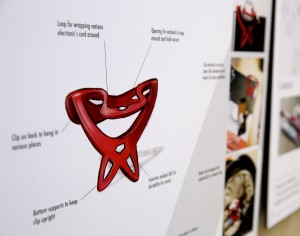Menomonie, Wis. — For a group of industrial design students at University of Wisconsin-Stout, it wasn’t just another day in the classroom.
It was a day of reckoning, academically speaking.
Associate Professor Jennifer Astwood had assigned them to design an injection-molded consumer product for the college-age market, something they should know a little about. They also were required to create a working prototype in a lab.
The final aspect of the project may have been the most pressure-packed: They would present their ideas to professional designers, including four from Target corporate offices in Minneapolis.
The presentation took place recently in the atrium outside Furlong Gallery in UW-Stout’s Micheels Hall. With students dressed in business casual and professionals perusing multiple display boards, the setting looked more like an art exhibit than a student project display.

UW-Stout industrial design students Nick Larson, left, and Ted Baumann, review their projects during a recent presentation to professional designers in Micheels Hall.
For seniors Ted Baumann, of Merrill, and Nick Larson, of Sheboygan, what started as a potentially nerve-wracking experience turned into a confidence-builder when they received positive feedback.
Baumann designed a toothbrush-toothpaste holder. Larson created a cord-wrap device, a product that would help people organize cords that dangle from personal electronic devices.
They presented their products together. Another aspect of the assignment was that pairs or groups of students would create products that work together or match in some way.
“Feedback on the product went really well,” Baumann said. “The professional designers liked that my design actually worked, looked nice and it was feasible to make with a two-part mold.”
Larson’s presentation included photos of how he envisioned his cord wrap being used. “The designers liked the real-life scenario of who would use this and why,” he said. “They wanted to know how we came up with the product and how we researched it.”
Students had four weeks to work on the project. Baumann and Larson said they each invested about 40 hours on their ideas and designs.
Three other students, juniors Holly Brummer, of Buffalo, Minn.; Luke Myhers, of Eau Claire; and Kayla Daken, of Bloomer, worked together to design a wall cellphone holder and a cord clip.
“It was good to get that feedback, such as on price-point issues, something we may not have thought of,” Brummer said.
The project didn’t end with the presentations. It turned into a multidisciplinary project as well. Students in plastics engineering and manufacturing engineering implemented the designs for manufacturability. They machined mold inserts, which would allow mass production of the part designs, according to Associate Professor Adam Kramschuster.
Professional perspective
One of the professional reviewers was Jeremy Odegard, human-centered design manager for Phillips-Medisize in Hudson. He is a 1997 graduate from UW-Stout in industrial design.
Another reviewer was Jill Holterhaus, a designer at Target headquarters in Minneapolis. She works in the company’s pet products area, including with the in-house Boots and Barkley brand.
She once was in the students’ shoes — she is a 1999 UW-Stout graduate in industrial design.
Overall, the students’ work impressed Holterhaus. “They were proactive, designing for a fast-changing consumer products market. The quality of work was good, and they had nice visual displays,” she said.
Students are learning the right approach, Holterhaus said. “The way they do projects is 100 percent the way we do them in the real world. The process never changes. I love the UW-Stout method,” she said.
Holterhaus called industrial design a “super-rewarding career” and said she enjoys her work in the large design division at Target.
Seeing students’ work also provides a fresh perspective on design, Holterhaus said. “I love giving back time and energy to the UW-Stout program, plus we’re alumni looking for new talent and UW-Stout has one of the few industrial design programs in the Midwest.”
For more information on industrial design and related programs at UW-Stout, go to www.uwstout.edu/artdes.



